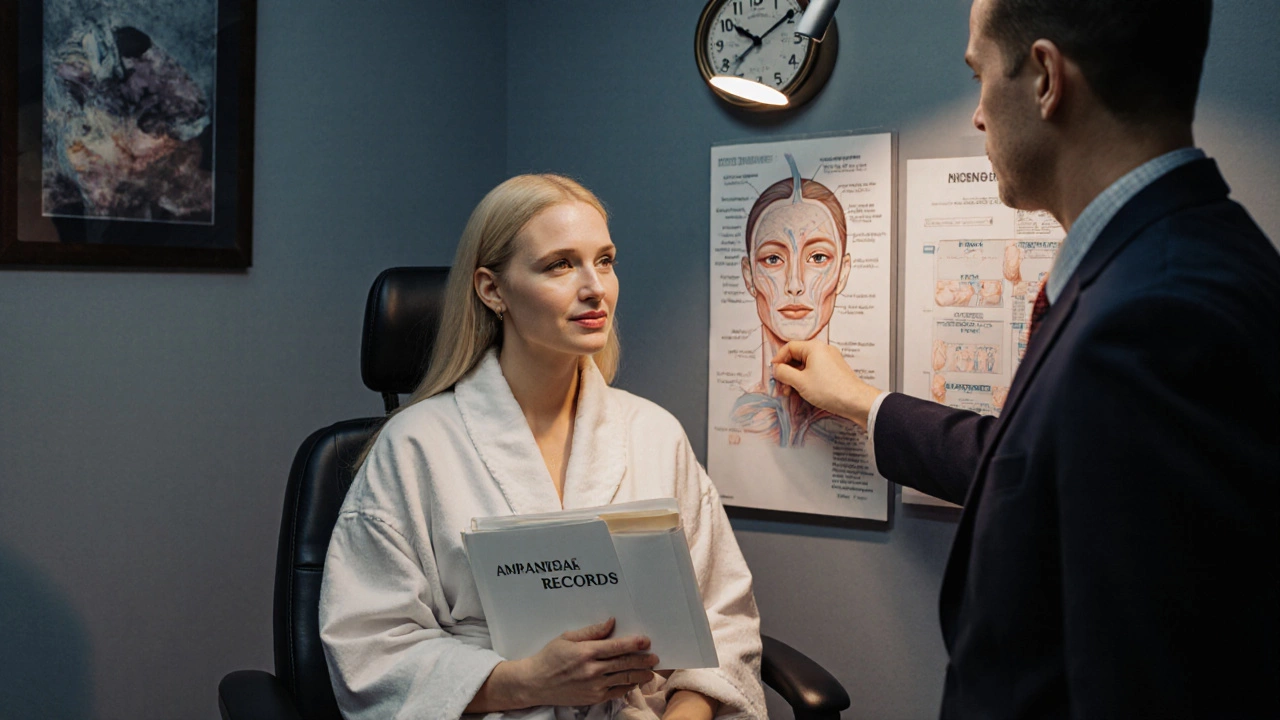
Plastic Surgery Risk Assessment Tool
Surgical Risk Assessment
This tool provides an estimate of your potential risk based on the number of procedures you've had. Remember, plastic surgery carries risks and should only be performed by board-certified surgeons.
When you hear the name of the person with the most plastic surgeries, you might think of a celebrity or a viral TikTok star. But the real answer isn’t about fame-it’s about medical reality, personal identity, and the limits of human transformation. The woman most often cited as having undergone the most plastic surgeries is Amanda Lepore, a model, performer, and icon in the New York underground scene. She’s had over 50 procedures since the 1990s, including facial feminization, breast implants, liposuction, and multiple silicone injections. Her journey isn’t about chasing beauty trends-it’s about becoming the person she always felt she was.
What Counts as a Plastic Surgery?
Not every tweak is plastic surgery. Getting Botox or fillers? That’s minimally invasive. A nose job, eyelid surgery, or breast augmentation? Those count. Amanda’s procedures include major reconstructive work: jaw reshaping, cheek implants, chin augmentation, and even multiple rounds of fat grafting to reshape her face and body. Some were done to correct complications from earlier surgeries. Others were to refine her appearance over decades.
There’s no official global registry tracking total surgeries per person. So when people say "the most," they’re relying on public statements, medical records leaked by insiders, or interviews. Amanda has been open about her surgeries in documentaries like My Genderation and interviews with Vice and Rolling Stone. She credits Dr. Steven Hutter, a New York-based plastic surgeon known for working with transgender patients and body modification artists, as her primary surgeon.
Why Do People Pursue So Many Surgeries?
Most people who get one or two procedures do it to fix something they’re unhappy with-a crooked nose, sagging skin, or asymmetrical breasts. But for a small number, it’s deeper. For Amanda, it wasn’t about looking like a celebrity. It was about aligning her physical form with her internal sense of self. She transitioned in the 1990s, long before gender-affirming care was widely understood or accessible. Every surgery was a step toward authenticity.
It’s not just about gender identity. Some people with body dysmorphic disorder (BDD) seek endless surgeries, hoping each one will finally make them feel "right." But studies show that for those with BDD, more surgeries rarely bring lasting satisfaction. In fact, the opposite is true-each procedure increases the risk of complications, scarring, and psychological distress.
Amanda doesn’t fit the BDD profile. She’s clear-eyed about her choices. "I don’t want to look like a Barbie," she said in a 2021 interview. "I want to look like me. And me is a work in progress."
The Risks of Too Many Surgeries
Every surgery carries risk. Even minor ones. But when you’re talking about 50+ procedures over 30 years, the numbers get dangerous. Repeated incisions lead to scar tissue buildup, which makes future surgeries harder and riskier. Silicone injections, which Amanda had multiple times, can migrate, harden, or cause infections that require emergency removal. Nerve damage, chronic pain, and loss of sensation are common long-term effects.
Surgeons in the UK and US have spoken out about patients who come in with a list of 20+ past surgeries. Many refuse to operate. "We’re not here to be the last step in a cycle of self-destruction," said one London-based plastic surgeon who asked to remain anonymous. "We’re here to heal, not to keep rebuilding."

Who Else Is Often Mentioned?
People often confuse Amanda with other high-surgery individuals. One is Michelle De Young, a woman from Australia who claims over 60 surgeries, mostly for body contouring. But her claims are unverified, and she rarely shares medical documentation. Another is Lauren Hutton, who had several facial procedures in her 50s-but only around five, all publicly documented and for aesthetic maintenance, not transformation.
Then there’s the myth of "the woman with 100 surgeries." That’s pure internet fiction. No verified medical record exists for anyone hitting that number. Even Amanda, the most documented case, is at around 50-55. Anything higher is speculation, often tied to clickbait headlines or deepfake videos.
What Happens When You Get Too Many Surgeries?
After a certain point, the body stops responding the way it used to. Skin loses elasticity. Fat doesn’t redistribute. Implants become encapsulated in scar tissue. The face can start to look unnaturally stretched or frozen. That’s not "perfect"-it’s medical wear and tear.
Amanda’s face today shows subtle signs of this. Her skin has a slight tightness around the eyes and jawline. Her lips are fuller than they were 15 years ago, but not as exaggerated as they were in the 2000s. She’s adjusted her goals. Now, she focuses on maintenance-minor touch-ups, laser treatments, and skin health. She’s learned that beauty isn’t about quantity of procedures, but quality of life.

Is This Common in the UK?
Plastic surgery in the UK has grown by over 40% since 2015, according to the British Association of Aesthetic Plastic Surgeons (BAAPS). But the number of people having more than five procedures remains tiny-less than 0.3% of all patients. Most people have one or two. The majority are women in their 30s to 50s getting breast lifts, tummy tucks, or eyelid surgery.
What’s rising is the number of people seeking revision surgeries-fixing bad work from overseas clinics or unlicensed practitioners. In 2024, the NHS reported a 27% increase in patients needing corrective surgery after botched procedures abroad. Many came from places like Turkey or Hungary, lured by cheap prices. But the long-term cost? Higher.
What’s the Real Story Behind the "Record"?
The idea of a "girl with the most plastic surgery" sounds like a tabloid headline. But the truth is more human. Amanda Lepore isn’t a spectacle. She’s a woman who used surgery as a tool to survive, to express herself, and to live without hiding. Her story isn’t about how many times she cut herself open. It’s about how many times she chose to keep going.
There’s no prize for having the most surgeries. No trophy. No certification. Just scars, memories, and the quiet courage to keep becoming.
What You Should Know Before Considering Multiple Surgeries
- Every surgery leaves scar tissue-it’s permanent and cumulative.
- Surgeons have ethical limits. Many won’t operate on someone who’s had more than five procedures without a psychological evaluation.
- Non-surgical options (fillers, lasers, radiofrequency) are safer for maintenance.
- Revision surgeries cost more and take longer to heal.
- Psychological support is not optional-it’s essential if you’re considering repeated changes.
If you’re thinking about multiple procedures, talk to a board-certified plastic surgeon in the UK. Ask for their opinion on your goals-not just what they can do, but whether they think you should do it. And if you’re struggling with how you look, consider seeing a therapist who specializes in body image. Surgery can change your face. It can’t fix how you feel inside.
Who has had the most plastic surgeries in the world?
The person most widely documented as having undergone the most plastic surgeries is Amanda Lepore, a model and performer who has had over 50 procedures since the 1990s. These include facial feminization, breast implants, liposuction, and silicone injections. While others claim higher numbers, none have been verified with medical records or public documentation to the same extent.
Is it safe to have 50+ plastic surgeries?
No, it’s not considered safe by medical standards. Each surgery adds scar tissue, weakens skin elasticity, and increases the risk of infection, nerve damage, and implant complications. Surgeons often refuse to operate on patients with excessive histories because the body can no longer heal properly. Amanda Lepore’s case is extreme and rare-most people who undergo multiple surgeries face serious long-term health consequences.
Do surgeons in the UK perform multiple surgeries on the same person?
Yes, but only under strict conditions. The British Association of Aesthetic Plastic Surgeons (BAAPS) requires psychological evaluations for patients seeking more than three procedures. Surgeons prioritize patient safety over aesthetics. Many will decline further surgery if they believe the patient is at risk of developing body dysmorphic disorder or is seeking perfection through repeated cuts.
What’s the difference between cosmetic surgery and reconstructive surgery?
Cosmetic surgery is done to enhance appearance-for example, rhinoplasty or breast augmentation. Reconstructive surgery repairs damage from trauma, illness, or birth defects, like fixing a cleft lip or rebuilding a breast after cancer. Some people, like Amanda Lepore, undergo procedures that blur the line-facial feminization is both cosmetic and reconstructive because it alters anatomy to match gender identity.
Are there any records of people with 100+ surgeries?
No verified medical records exist for anyone having 100 or more plastic surgeries. Claims of this nature are usually internet myths, exaggerated social media posts, or fictional stories. Even the most extreme documented cases, like Amanda Lepore’s, are under 60. The human body simply cannot withstand that many interventions without life-threatening complications.
Can plastic surgery change your identity?
For some people, yes-especially those who are transgender or non-binary. Surgery can help align physical appearance with internal identity, reducing gender dysphoria and improving mental health. But surgery alone doesn’t change who you are. Identity comes from within. Surgery can help you live as your true self, but it doesn’t create it.